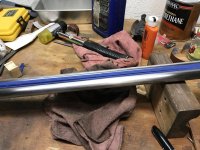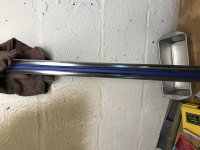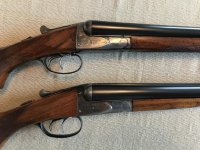Gasoline used as a parts cleaning solvent prior to bluing was what was recommended back when the Carbona Oil blue system (American Gas Furnace) was in use.
I imagine the gasoline back then (just prior to WW1 and up to just prior to WW2) was quite different than what is pumped today in that it lacked a lot of extra additives.
I tried using it back when I first started rust bluing,,or trying to! That was in the 60's.
I didn't have good luck with it. Maybe I just didn't do a good job using it.
Now I've settled on using a scrub down of a hot water (not boiling) soln of Tri-Sodium Phosphate cleaning powder.
It's the same stuff Brownells will sell you as their '909 Cleaner' for bluing.
A scrub brush and that stuff in a fairly concentrated soln and it'll cut and remove any oil, grease, finger prints ,ect.
Don't use it in a boiling soln,,,it'll leave strange colored (green & yellow) deposits on the steel as well as lightly etch it.
Brownells advises the same for their stuff.
After the scrub, a warm water rinse and then a cool water rinse. PAt dry with 'plain' paper towels. Plain Paper,,not the type with perfume scents, soap, or pretty printed designs on it.
Those raspy brown public rest room type paper towels are the best.
The pretty white and print ones will leave traces of all those nice hummingbird pictures and flowery smells back onto the chemically clean metal and screw up the bluing.
If you are Slow Rust Bluing,,don't apply the rusting soln unless the metal parts are at room temp. Applying it with the parts warm or hot will risk a copper plate look from many of the commercial soln's as they have a trace of copper sulfate in them as a rule.
Those plated areas will not rust or rust the same as none plated areas and back to polishing you will go.
If Express (Quick Rust) Bluing,,as long as the parts are hot, go right ahead and apply the soln.
Rusting soln made for Express Bluing IS NOT the same stuff as soln made for Slow Rust bluing.
Slow rust bluing you can use a lot of common products.
SalAmmoniac was popular. Ammonium Chloride by chemical name.
It's soft soldering flux in a bar or small block form. Most welding supply stores will have it or off the Web it can be bought. Very inexpensive.
It's fairly soft and you simply cut chips off and disolve it in water. Then use that soln to apply to the metal to slow rust it.
Works well.
A weak soln of Hydrochloric acid (muriadic acid) will do it. Keep it weak as you want a controlled rusting, not a canker mess of rust.
Dissolving iron in Hydrochloric acid has always been a favorite slow rust soln
Makes a lot of smoke and gives off chlorine gas in the process, so don't do it in the kitchen. When you can't disolve anymore nails or steel wool into the acid, let it settle and then pour off the stuff from the top and leave the crud in the bottom of the jar.
You have made Ferric Chloride. Or you could just go buy some off of Ebay.
Good etchant for use in Damascus bbl finishing too. You use it at only about a 5% solution though it that procedure.
I like to use Laurel Mtn Rust Brown for slow rust blue. Rust blown turns blue in the boiling process.
For Express Blue I use Mark Lee Express Blue.
I've used about every brand available and tried more home brews than I care to think about and have settled on these two for rust bluing.
Others work just as well, it's technique and small details that can make or destroy a fine bluing effort.
Keep oil out of the process.
If you see the slightest hint of an oil slick on the water surface in the tank, dump the water and scrub the tank clean.
If you think there might be some in there and you already have parts in the tank and it's boiling,,just before you remove the parts run the heat way up to bring the water to a rolling boil. That breaks up the surface and keeps any oil slick on the surface from forming in any size.
Then when you yank the parts out, they come through the surface and there's less of a chance of being covered with a film of oil.
If you transfer oil to the carding brushes or wheel,,you will get oil onto all the parts that you card with it.
It'll be there when you apply the next coating of rusting soln and that will just spread any oil out across the parts surface again.
If you get a streak or blemish in the bluing as you go along but the rest of the finish looks fine,,take a small patch and wet it with acetone and rub it over that steak/blemish. That'll remove any oil or dirt in that area.
Throw that patch away...
Then take a small piece of scotchbrite,,I like the Maroon or Grey colored stuff and carefully scrub that area down till the blemish is gone.
Yes you will remove the bluing in that area along with the blemish or streak. But you want the blemish gone.
Then carefully blend the edges of the now polished out area iinto the surrounding blued finish.
When satisfied, go right on with your next coat of soln. Doesn't matter if you are doing Express Rust or Slow Rust.
That scrubbed out area will return to catch up in color with the surrounding bluing in 1 or 2 cycles.
The reason is that you have not removed any of the bluing that is down in the pores of the steel.
9 times out of 10 you'll be able to just continue on with applying cycles of soln, boiling and carding and not have to stop bluing and repolish the entire bbl/part and start bluing all over again.
If there are gold or silver inlays (or copper or brass) in the steel, be careful not to apply rusting soln that has any Mercury compounds in it.
This is especially true of Express Blue compounds which most all used to have Bi-Chloride of Mercury in them.
The compound made the soln's rust really well, but the mercury in those compounds will 'plate' onto any non-ferris metal when applied hot,,just as you do when Express Bluing.
The mercury 'plating' looks for all the world like a silver or nickel plating. In fact it used to be an old 'trick' to touch up worn nickel plate on brass framed revolvers by using it.
The plate of mercury is tough and won't just rub off. You have to polish or scrape it off.
So if there's an gold inlay or two on the Kornbrath engraved '03Sporter floor plate that you're figuring to touch up the looks a little by a coating or two of Express Rust Blue,,think twice before turning the 2 critters into silver inlays.
Brass/gold sight beads, any gold line inlay, any of it will end up mercury plated.
The good news is that Mercury compounds have been mostly removed from society and bluing soln's.
The old Herters Belgian Blue Express soln was one that used it.
That was discontinued with the fading of Herters. But Brownells brought the Belgian Blue back onto the market some years back and they said it was the same as the orig. I wondered if it still had Mercury.
I bought a small bottle and tried the swab it onto warm brass trick and sure enough it plated Mercury (or a silver colored metal) onto the brass surface. I wouldn't have thought they'd have brought a merc compound to the market. but....
I stayed away from it and still use the two mentioned above.
Another was Birchwood Casey quick Brown soln.
Boil the browned parts and you got a beautiful blue with the stuff. But it also had the mercury in it. B/Casey changed the formula in the stuff in the 80's sometime.
Stay away from the dangerous chemicals, then you won't shake like me.
Sorry for the long post.









